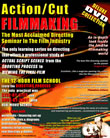|
|
FEATURES
- Writing a Great Screenplay
Page 6
|
 |
|
|
|
|
|
|
|
|
| Sponsors |

|
|
|
 |
|
 |

|
|
Writing a Great Screenplay
|

|
|
Another important "do" in script writing is to focus on the dialogue of the story. Dialogue is the force that carries the film and could make or break the picture. Even if a film has spectacular scenery and or a fantastic plot, if the dialogue is lacking the film will most likely not be successful.
The format and rules that apply to dialogue are formulated to aid clarity and conciseness. Visually, the lines spoken by a given character in a script are obvious for they are located in the center of the page and are relatively short. Basic formatting of dialogue begins at a tab setting of 29 and ends at a tab setting of 60.
There are four basic rules that should be applied to all script dialogue. The first rule is to spell out all one and two digit numbers. Three or more digits may be written numerically. Rule number two is to spell out indications of time. For example, do not write 2:15, rather, write two-fifteen.
Rule number three is to spell out all personal titles except Mr., Mrs., and Ms. Finally, rule number four is never hyphenate a word from one line to the next unless the word is normally hyphenated anyway. An example of this would be something like son-in-law.
The last "do" for writing scripts is to always stay within the acceptable page count. As previously mentioned, a two hour film should be approximately 120 pages. Generally films are between approximately 100 to 115 pages in length. When a script exceeds the standard length, producers are leery of the script because much of the time this means that the writer is inexperienced in script writing. Experienced writers know standard format and will generally stick to it.
Recently in the film industry there has been quite a number of films exceeding 2 hours in the theater. In some situations, especially when an epic-type of film is being made (ex. Braveheart or Titanic), exceeding two hours is needed to portray the entire story.
There are several don'ts that should be followed when formatting a script. The first of these is do not number scenes. The story should flow from one scene to the next; it is not a play that draws a curtain after every scene. Another is that there should be no shot angles in the script unless absolutely necessary for clarification of the scene.
|

|
|
|
|
|
Do not add scene endings or transitions (such as CUT TO or DISSOLVE TO)
|
|

|
|
Early draft scripts should contain few if any shot angles to facilitate smoothness and ease of reading. Get your point across, but keep the script as simple as possible. Do not jumble up the script with unnecessary wording and direction, make it easy to read so that someone will actually take the time to read it.
Do not add scene endings or transitions (such as CUT TO or DISSOLVE TO). A scene ending is defined as specific technical instructions indicating the movement from one scene to another. It seems obvious that when one moves from one scene to the next that we CUT TO the next scene, and therefore writing CUT TO in the script is unnecessary.
It is only needed in a script when there is not a logical progression from one scene to the next. A perfect example of this would be the movie Pulp Fiction. Because the film moves around among different characters and situations along with jumping back and forth from present to past, having CUT TO in the script may be needed for clarification.
While writing scripts, avoid standard abbreviated terms in direction. Although there are words that can be abbreviated in direction (for example personal titles), these words can not be abbreviated in the dialogue. There are however, a few terms that require abbreviation in direction, such as f.g. (foreground), b.g (background), O.S. (off screen) and M.O.S. (without sound). Another thing to be avoided while writing is that of personal (parenthetical) direction to the character, except again, where clarification is absolutely necessary.
Personal direction, which should be used sparingly, consists of those special, usually short instructions intended for a specific character and no one else. Personal direction should be kept to a maximum of four lines long. It is also a rule that a page should not be ended with personal direction. If dialogue is to be broken from one page to the next, the break must come before that of personal direction. Personal direction should also never be the ending to a passage of dialogue.
|
|
|
|
|
|
|
|

|
|
|

|

|
|
top of page
|
Home
Page |
Contests
| Indies
| Features
| News
| Resource
Links
| Advertise
With Us |
Important
disclaimer
Copyright ©
1999-2011 by FilmMakers.com. All rights reserved.
FilmMakers.com
is a division of Media Pro Tech Inc.
|

|
|
|